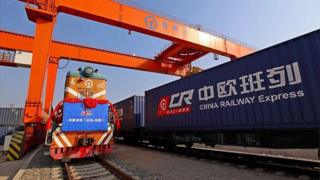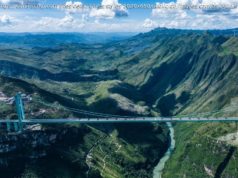 It’s not on a boat, it’s not on a plane, it’s on a train. The newest way to send your freight from China to Europe involves spending 15 days on a train that doesn’t have a buffet car in sight.
It’s not on a boat, it’s not on a plane, it’s on a train. The newest way to send your freight from China to Europe involves spending 15 days on a train that doesn’t have a buffet car in sight.
On 3 January in Yiwu in eastern China, a bright orange locomotive pulling 44 containers laden with suitcases, clothes and an assortment of household goods set off on a 7,500-mile (12,000km) journey to western Europe.
Ten containers were taken off at the German cargo hub of Duisburg. The rest made up the first cargo train from China to arrive in London at Barking’s Eurohub freight terminal.
London is the 15th European city to find its way on to the ever-expanding map of destinations for China’s rail cargo. Last year, 1,702 freight trains made the voyage to Europe, more than double the 2015 figure.
Yiwu Timex Industrial Investments, which is running this service with China’s state-run railways, says prices are half that of air cargo and cut two weeks off the journey time by sea.
The UK’s biggest supermarket, Tesco, doesn’t have any goods on this particular train but does use rail to carry toys, electrical goods, homeware and clothing from China to European rail hubs such as Bratislava in Slovakia and Krasnaje in Belarus.
Alistair Lindsay, Tesco’s head of global logistics, says the supermarket prefers shipping its goods because this is the most environmentally friendly way, as well as offering the best value for money, but that “where we need to move products quicker we have that option to do it by rail”.
This decision would normally be driven by customer demand for particular products, he says.
It demonstrates how market demand and the realities of globalisation are increasingly allowing China’s President Xi Jinping to realise his ambitious plan to revive the ancient Silk Road.
For centuries the fabled trade route from the ancient capital of Xian provided a link to the bustling markets of European cities such as Istanbul and Venice.
In the 21st Century China has become the world’s biggest exporter, with the export of goods totalling $2.28 trillion (£1.85tn) in 2015 .
This rail expansion is part of President Xi’s “One Belt, One Road” (OBOR) trade policy. For Beijing it offers another way to sustain its economic growth.
Kazakhstan is one of the countries on the route and it was there that Mr Xi first outlined his vision in a speech in 2013 saying, “This will be a great undertaking benefiting the people of all countries along the route. ”
Extolling the virtues of globalisation was a theme he repeated again at Davos this week.
For some, this is as much political as economic, offering Beijing the chance to project soft power as well as demonstrating it has the influence to thread disparate nations from Russia to Spain together.
“[OBOR] is set to become Xi Jinping’s grand legacy,” says Dr Sam Beatson, of King’s College London.
“Regardless of the returns on offer… the policies will continue to be pushed as a means of seeking to fulfil Xi’s dream under his leadership. ”
One of the other legacies President Xi is trying to tackle is China’s pollution problem. While rail cargo is not as green as sea transport it emits less carbon dioxide (CO2) than air travel.
This is the “first argument when trying to get our customers to re-evaluate their options”, says Johan Ignell, rail freight manager at Swedish cargo firm Greencarrier.
It calculates that a 40ft (12m) container with 20 tonnes of cargo would account for just 4% of the CO2 emissions it would take to move it by air (though emissions would be more than halved again if it were moved by sea).
Freight transport accounts for about 7% of global greenhouse gas emissions, but it is “fraught with difficulty” to compare emissions from different transport modes, says Prof Alan McKinnon of Germany’s Kuehne Logistics University.
Prof McKinnon, one of the authors of a 2014 report by the Intergovernmental Panel on Climate Change (IPCC) , says “load factor, energy efficiency and power sources all make a difference and can be hard to ascertain”.
He adds: “While shifting air cargo to rail will certainly cut emissions, container shipping will continue to command a significant carbon advantage over transcontinental rail, particularly now that most vessels are slow steaming to save fuel. ”
There is also a business case for this emerging trade route to grow. Not least among European companies looking to export to China.
At the moment there are no plans to run a return train service from London but that could change quickly. China is already the European Union’s second biggest export market – though there is an EU trade deficit in goods of about $190bn.
For UK companies facing up to the reality of Brexit, China is an attractive proposition and the train carries new opportunities.
Brand Avenue is a company that already exports British-made goods including cosmetics and jewellery to China, and chief executive Jody Jacobs says he’s exploring moving to rail.
“We deal a lot in goods which weigh a lot in comparison to their volume [which is] where airfreight becomes expensive, such as cosmetics and baby food.
“So for us a service which is quicker than sea and cheaper than air is a great middle ground. ”
For established cargo companies rail also offers the potential for growth. Shipping lines have seen profits fall because of overcapacity attributed to the aftermath of the global financial crisis.
The world’s biggest shipping company, Maersk, told the BBC it is investigating “possible opportunities” in long-distance rail, though it sees them as supplementary to sea and air routes.






